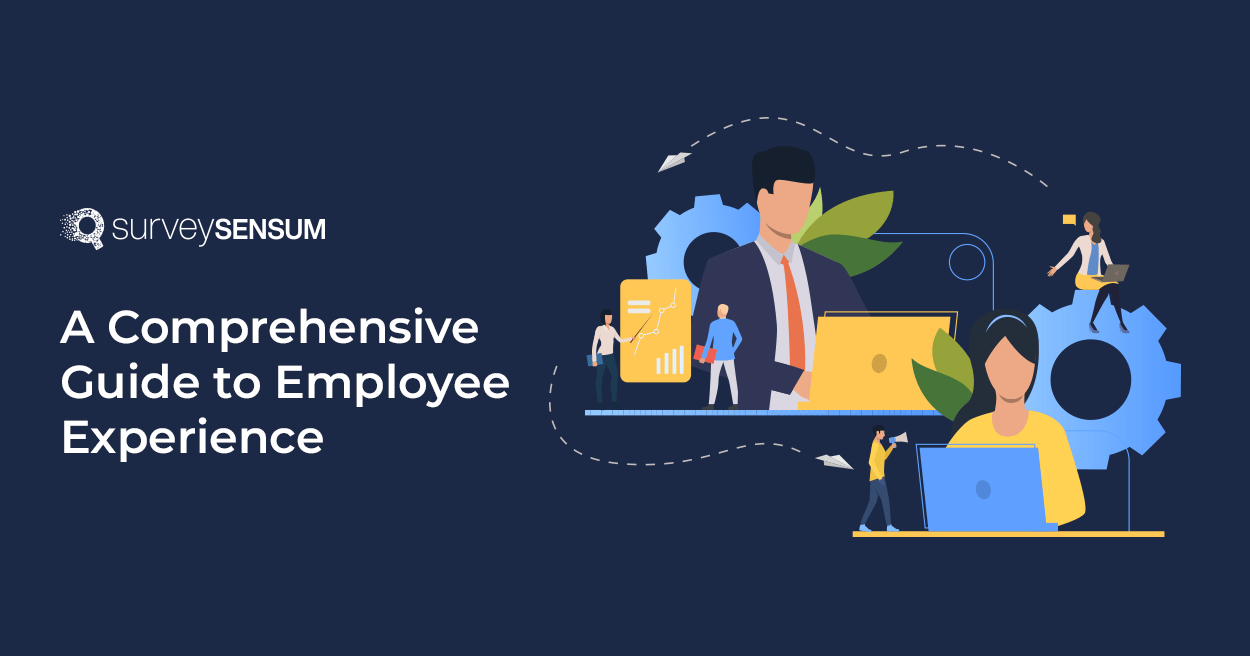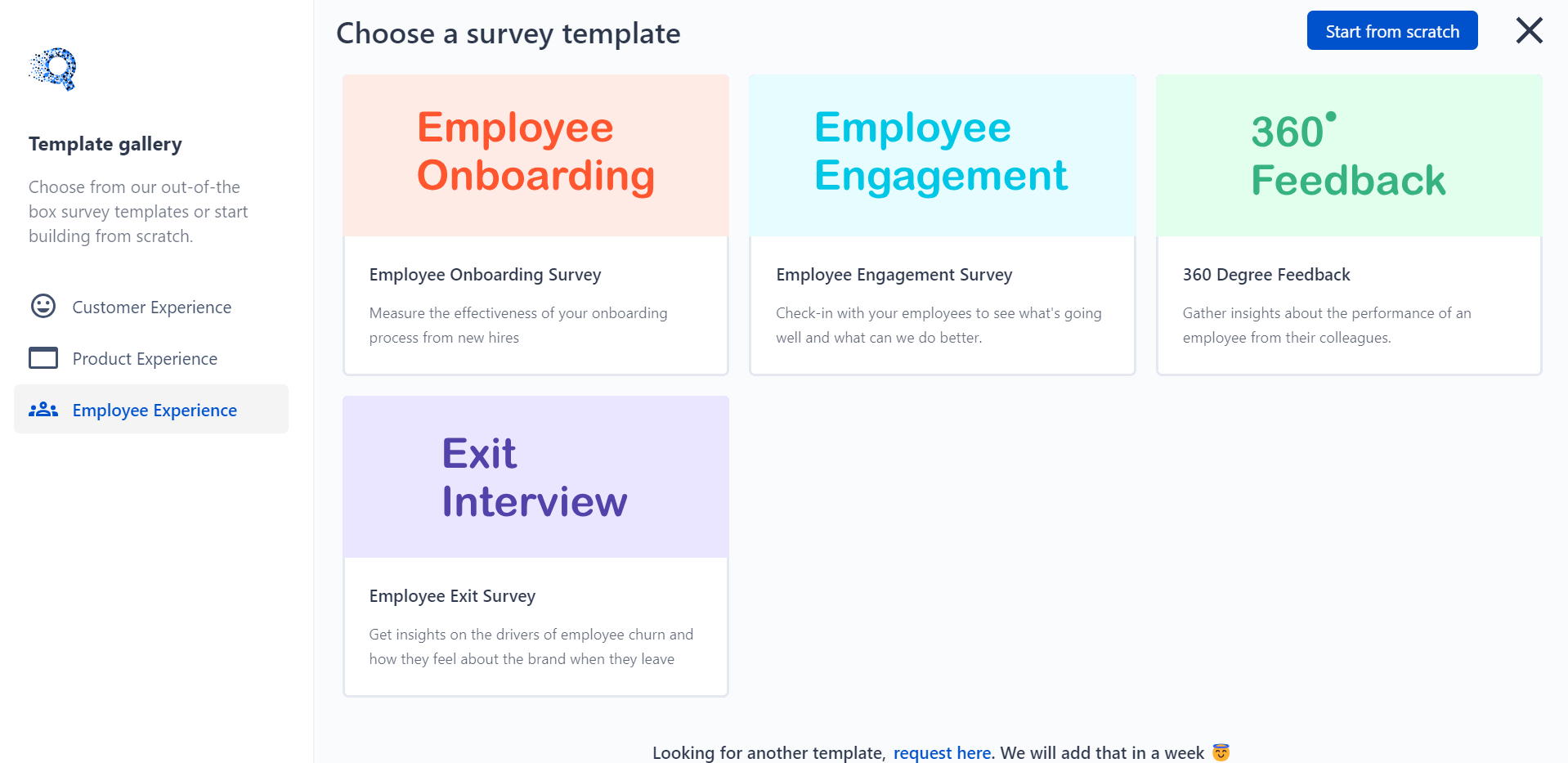Employees can make or break your business!
Yes, that’s right!
Your customer satisfaction and loyalty are directly linked to how you treat your employees. The more engaged and satisfied your employees are with you, the more satisfied and loyal customers you will gain.
In fact, efficient employee engagement strategies can help you gain two times more loyal customers. And not only that, businesses with highly engaged employees achieve twice the annual net income than businesses whose employees are less engaged.
After working with different companies, across industries, I have realized that businesses need to understand the impact their employee satisfaction has on their business performance. The more satisfied your employees are, the more effort they will put into their work – directly influencing customer loyalty, repeat business, and positive word-of-mouth marketing, all of which are essential for sustainable growth.
Now, this is where Employee Experience comes in – it’s like the Michelin star rating for workplaces, and I am here to show you how to earn your three-star shine.
So, let’s start by understanding what is employee experience and how you can improve it with the help of a robust employee feedback tool.
Understanding Employee Experience
- What is Employee Experience?
- Key Components of Employee Experience
- Impact of Employee Experience on Customer Satisfaction
Employee Experience Management
Elevating Employee Experience Through Continuous Feedback
- Find the Right Survey Tool
- Start Gauging Employee Feedback
- Establish Regular Feedback Cycles and Close the Loop
Understanding Employee Experience
What is Employee Experience?
Employee Experience refers to the sum of all interactions and touchpoints an employee has with their employer, encompassing the entire journey from recruitment to departure. It includes the physical, cultural, technological, and emotional aspects that shape the employee’s perception of their workplace.
It’s the entire employee journey, from the first interview jitters to the bittersweet farewell (okay, hopefully not bittersweet!). It’s the office vibe, the career ladders, and the feeling of “This is where I belong.”
But, why does it matter?
– Because happy employees are profitable employees. They churn out better work, stay loyal, and attract their talented friends. It’s a win-win-win situation!
So, let’s discuss more, shall we?
Why is Employee Experience Important for Organizational Success?
A positive Employee Experience is directly linked to increased engagement, productivity, and retention. It contributes to a healthy work environment, fostering employee loyalty and, consequently, organizational success.
- Productivity Takes Flight: Research by the University of Warwick found that happy employees are, on average, 12% more productive than their counterparts. When employees feel a sense of purpose and connection to their job roles, they are more likely to put in more effort, resulting in increased productivity.
- Retention Becomes a Breeze: The Corporate Leadership Council reported that highly engaged organizations have an 87% employee retention rate, compared to 47% for companies with lower engagement. This shows that top talent sticks around when they love their workplace, saving you the cost and headache of constant turnover.
- Innovation Ignites: A positive environment fosters creativity and out-of-the-box thinking, leading to game-changing ideas. A survey by McKinsey found that more than 70% of senior executives believe that innovation will be at least one of the top three drivers of growth for their companies in the next 3-5 years.
These statistics are not just mere numbers, they underscore the business impact of engaged, satisfied employees on productivity, retention, and innovation, emphasizing the need for businesses to invest in creating a positive workplace culture.
But what are the key components of creating a positive Employee Experience that you need to focus on to create a positive Employee Experience for your business?
Let’s find out.
Key Components of Employee Experience
The Employee Experience comprises various elements, including the physical workspace, company culture, leadership, opportunities for growth, work-life balance, and the overall work environment.
Here’s what you need to pay attention t
- The Workspace: Make it a place people actually want to be, with comfy chairs, natural light, and maybe even a foosball table (because who doesn’t love a good mid-meeting smackdown?).
- The Culture: Build a culture of collaboration, inclusion, and open communication. Think trust, transparency, and enough high fives to fuel a rocket launch.
- Growth Opportunities: Show your employees they’re not just cogs in the machine. Offer training, mentorship, and career development programs that help them reach their full potential.For example, for employees interested in cloud technologies, providing resources like AZ-900 Exam Dumps can support their journey in earning valuable certifications and expanding their skill set.
- Work-Life Balance: Life happens outside the office too. Promote healthy boundaries and flexible work arrangements so your employees can thrive in all aspects of their lives.
The organizations that invest most heavily in EX are found:
- 11.5x as often in Glassdoor’s Best Places to Work
- 4.4x as often in LinkedIn’s list of North America’s Most In-Demand Employers
- 2.1x as often on the Forbes list of the World’s Most Innovative Companies
- 2x as often in the American Customer Satisfaction Index
Source: Jacob Morgan
Now, you understand Employee Experience and its importance but what about its impact on customer satisfaction? Let’s discover.
Impact of Employee Experience on Customer Satisfaction
When your team is happy, it’s like magic for customer experience – it’s the secret sauce for a booming business. This correlation between employee satisfaction and customer satisfaction isn’t just a random thought- it’s backed by research, and one such significant research is by Glassdoor.
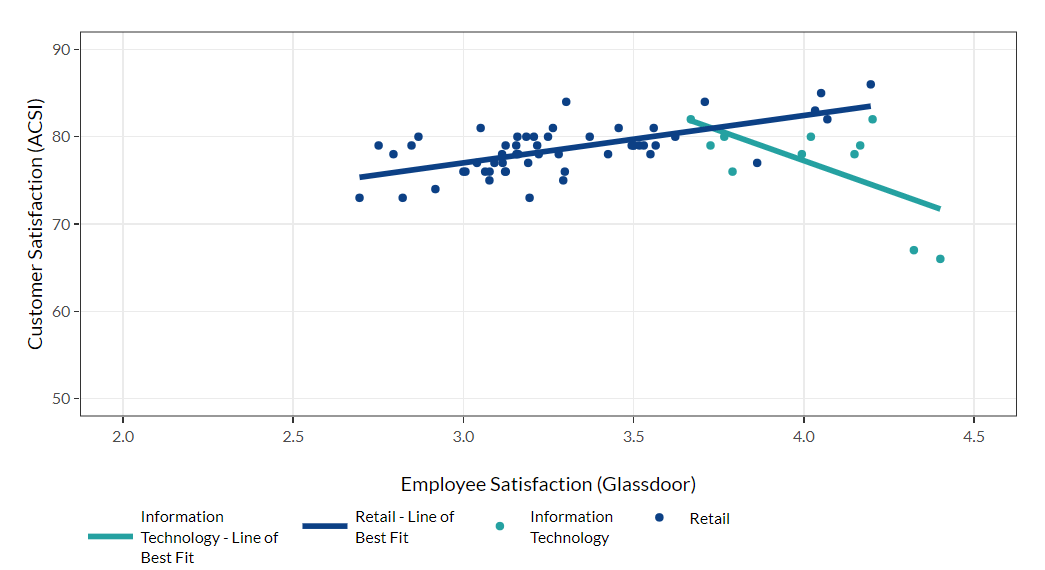
Glassdoor has quantified the impact of employee experience on customer satisfaction. The data reveals a clear correlation – a 1-point increase in a company’s employee satisfaction rating corresponds to a 1.3 increase in customer satisfaction. It highlights that by investing in and promoting a positive work environment that fosters employee satisfaction, companies not only benefit internally by having more engaged employees, but they also experience positive outcomes externally.
Boost employee satisfaction with different types of employee experience surveys!
Now, that you understand the impact your happy employees have on customer satisfaction, let’s understand how to create a positive employee experience with Employee Experience Management.
Employee Experience Management
Employee Experience Management (EXM) involves a strategic approach to design and cultivate a positive work environment. It focuses on creating a seamless, enjoyable journey for employees, ultimately enhancing their satisfaction and productivity.
It is a holistic approach that aligns employee expectations with organizational goals. And involves analyzing and optimizing every aspect of the employee journey to create a positive and fulfilling experience.
Wait, there is one big player in the employee journey – Enter the Digital Employee Experience.
Digital Employee Experience
Digital Employee Experience refers to the impact of digital tools and technologies on the overall work experience. It plays a pivotal role in enhancing efficiency, communication, and collaboration within the organization.
Role of Technology in Enhancing EX
Technological tools, such as collaboration platforms, employee portals, and communication apps, play a crucial role in streamlining processes, fostering connectivity, and contributing to a positive digital work environment.
- Collaboration tools: Break down communication silos with platforms like Microsoft Teams that connect everyone, from the corner office to the remote island paradise (where your marketing team is brainstorming their next genius campaign, of course).
- Employee portals: Give your employees one-stop access to everything they need with tools like Workday or Bamboo HR, from pay stubs to company policies to that hilarious meme generator (because laughter is the best medicine, even at work).
- Personalized learning platforms: Help your employees upskill and reskill with custom learning platforms, like LinkedIn Learning, that fit their needs and goals.
- Employee Feedback Platforms: Employee feedback platforms, like SurveySensum, allow you to gather feedback from your employees, on a regular basis, through surveys, pulse checks, and performance reviews.
However, even the coolest digital tools need constant fine-tuning! That’s where the cycle of continuous employee feedback comes in.
Elevating Employee Experience Through Continuous Feedback
Employee feedback helps you to:
- Gather regular feedback from employees, which allows them to feel heard and valued.
- Identify both individual and organizational strengths and weaknesses.
- Provide your employees with insights into their performance. This, in turn, enables them to make necessary improvements.
- Foster transparent communication within the organization.
Now, how to implement effective feedback mechanisms? Here’s how.
Create a continuous feedback mechanism to elevate your employee experience!
Implementing Effective Feedback Mechanisms
Implementing effective feedback mechanisms is crucial for understanding and enhancing the employee experience within an organization. Here’s a detailed breakdown of how to do that.
1. Find the Right Survey Tool
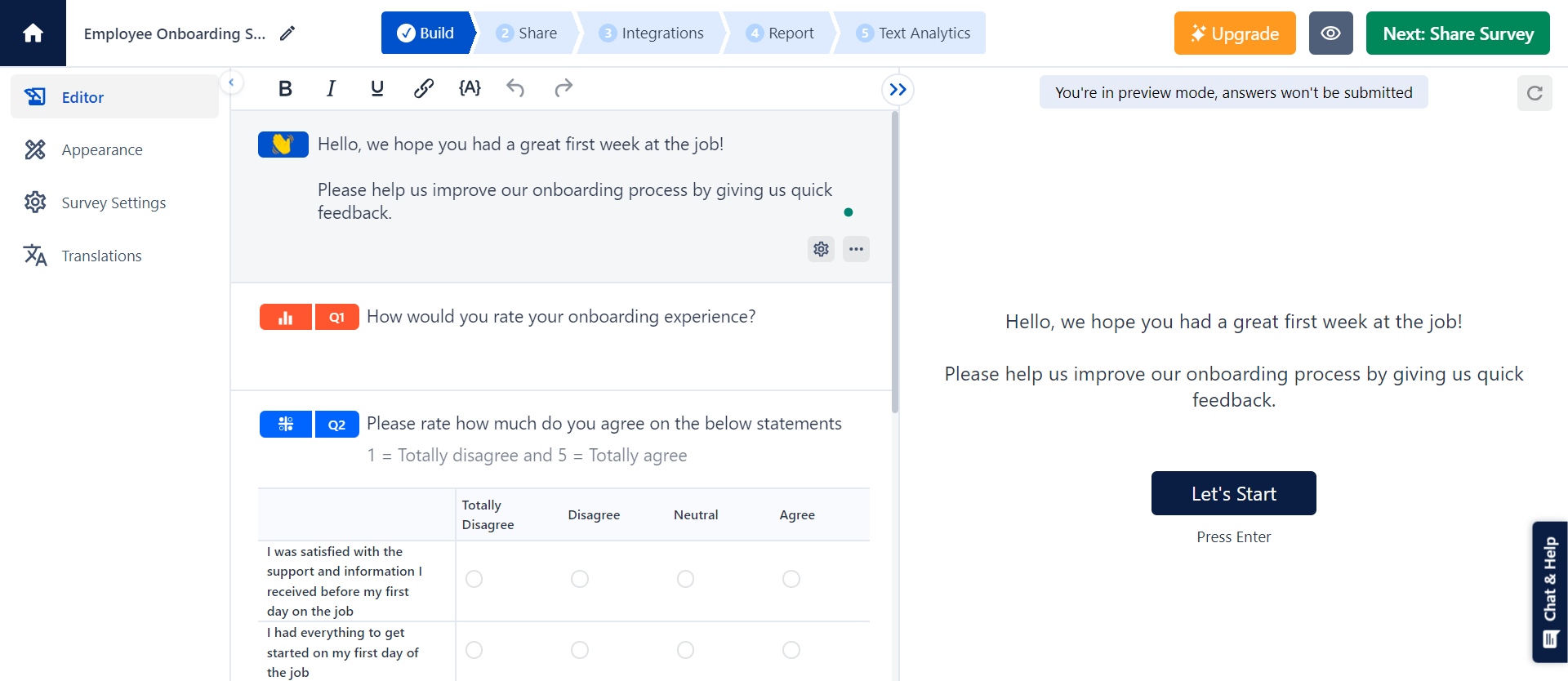
- User-Friendly and Adaptable: Choose a survey tool that is easy for employees to navigate. User-friendly interfaces encourage higher participation rates. Additionally, the tool should be adaptable to different survey formats and questions.
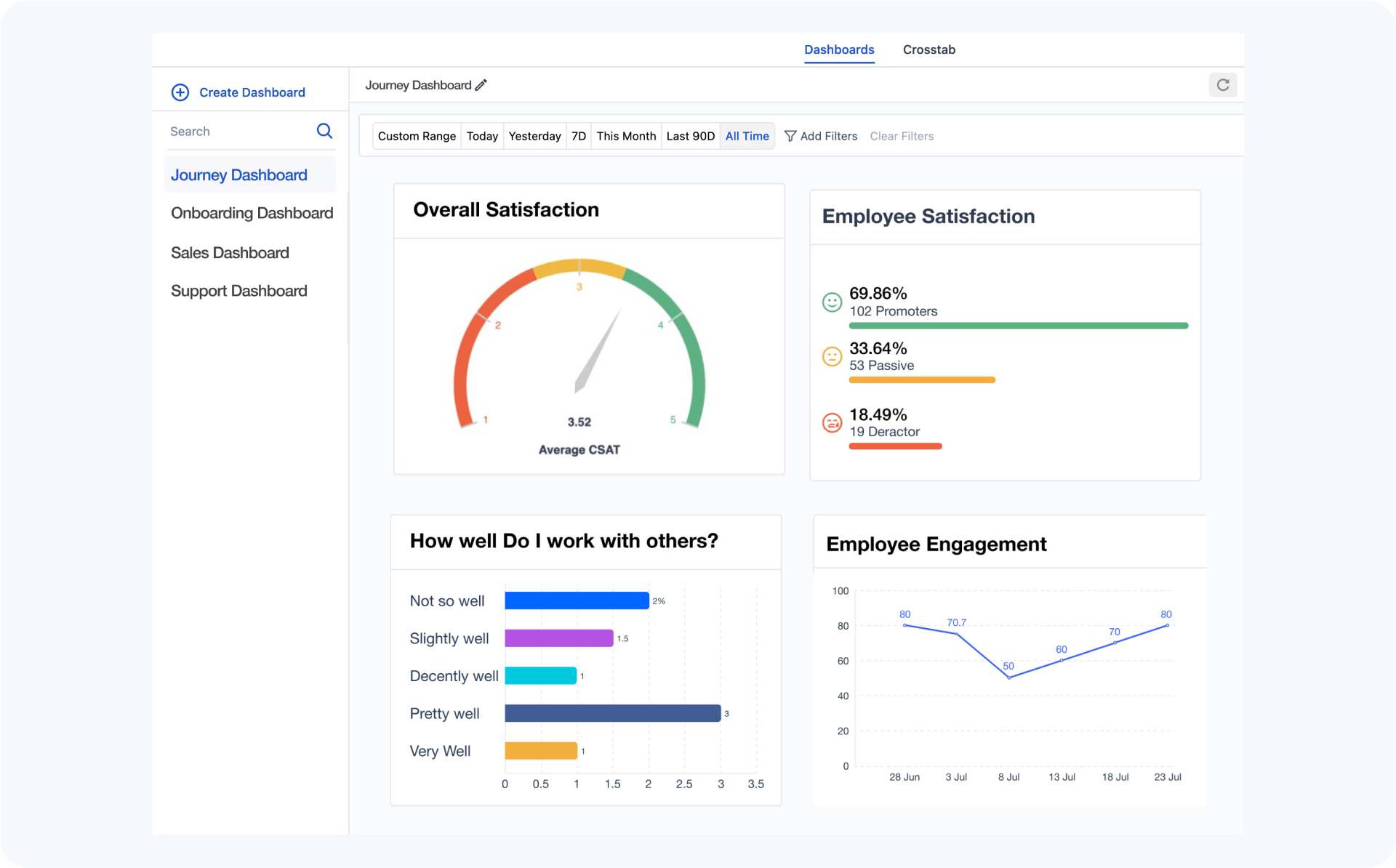
- Clear, Actionable Insights: The survey tool should provide insights that are easy to interpret and act upon. Clear analytics and reporting features are essential for turning survey responses into actionable plans.
2. Start Gauging Employee Feedback 
- Employee Experience Survey: Launch an Employee Survey to capture a comprehensive view of the employee journey within the organization. This survey can cover various aspects such as work environment, company culture, and overall job satisfaction.
- Specific Questions: Instead of generic inquiries, ask specific questions about work experiences, job responsibilities, and the work environment. This specificity helps in obtaining detailed and actionable feedback. Also, mix different question types like open-ended, Likert scale, rating scale, etc.
- Data Analysis: Use analytics tools to interpret survey data, especially open-ended ones, and identify patterns, trends, and areas for improvement.
Types of employee experience surveys you can send to your employees
- ENPS Survey: Measures employee loyalty and likelihood to recommend the company as a good place to work.
- Pulse Survey: Short, frequent surveys to capture real-time feedback on specific topics.
- 360-Degree Feedback Survey: Collects feedback from an employee’s peers, superiors, and subordinates.
- Onboarding, Engagement, and Exit Survey: Specific surveys tailored to different stages of the employee journey.
- Training Feedback Surveys and Performance Reviews: Assess the effectiveness of training programs and overall job performance.
So, launch an employee experience survey with SurveySensum to understand your employee satisfaction.
3. Establish Regular Feedback Cycles and Close the Loop
Analyze and act! Don’t just collect dust with your survey data, turn it into actionable plans. Develop strategies and initiatives to address specific employee concerns or areas that need improvement and communicate these changes to your customers, hence closing the feedback loop. This step demonstrates a commitment to fostering a positive work environment.
And, here are the benefits of gathering regular feedback for both employees and employers
- Regular feedback provides employees with insights into their strengths and areas for improvement.
- It reinforces a sense of purpose and recognition, enhancing the overall employee experience.
- Actively involving employees in the feedback process will boost motivation as employees are more likely to stay engaged and committed to their work if they see that their input leads to positive changes.
- Regular feedback fosters clear communication between employees and management.
- This proactive approach contributes to higher employee retention rates, as employees feel supported and valued.
Remember, feedback isn’t a one-time dish, it’s a continuous smorgasbord.
Implement regular surveys, pulse checks, and open-door policies to keep the conversation flowing. And most importantly, act on that feedback!
Turn their digital gripes into tech triumphs, showing employees their voices truly matter.
Measuring Employee Experience
- Employee Engagement Surveys: These go beyond simple “satisfied/dissatisfied” and delve into areas like motivation, commitment, and overall connection to the work. Imagine them as enchanted maps revealing where employees feel lost and where their engagement takes flight.
- Employee Net Promoter Score (ENPS): Ask employees how likely they are to recommend your company to others. Think of it as a magic mirror reflecting your company’s reputation through the eyes of your employees. A high NPS score? That’s a golden dragon of loyalty soaring your praises across the land!
- Exit Interviews: These are treasure chests overflowing with insights from departing employees. Listen to their gripes and triumphs, identifying areas where your EX needs a magical upgrade.
- Retention rates: Happy employees stay! Track how many employees are setting sail from your company ship. A low turnover rate? That’s a clear sign your EX efforts are creating a harbor so pleasant, your crew chooses to stay!
- Performance Reviews: These reveal not just results, but how employees feel while achieving them. Are they stressed or energized? Do they feel supported or isolated? Imagine them as crystal balls showing the impact of EX on performance, highlighting areas where a sprinkle of magic can boost productivity.
- Customer Satisfaction: Happy employees make happy customers, it’s that simple! Track customer satisfaction alongside internal metrics to see how a positive EX ripples outward, creating a customer service experience that shines brighter than a disco ball in a fairyland.
Now, let’s move on to the last, but not least, the segment of guide and understand how to improve the overall employee experience.
How to Improve the Employee Experience?
Here are a few tips on establishing a continuous strategy to improve your employee experience.
- Participatory Decision-Making: Involve employees in decision-making processes, especially those that directly affect their roles and work environment. Seek their input on key initiatives, projects, and workplace policies.
- Effective Two-Way Communication: Ensure that communication channels are not only top-down but also bottom-up. Create platforms for employees to share their ideas and concerns with leadership.
- Recognition Programs: Implement employee recognition programs to acknowledge and celebrate achievements, milestones, and exceptional contributions. Recognizing and appreciating employees fosters a positive work environment.
- Professional Growth Opportunities: Provide opportunities for continuous learning and development. Support employees in acquiring new skills and knowledge that align with their career goals.
- Flexible Work Arrangements: Implement flexible work arrangements, such as remote work options or flexible hours, to support a healthier work-life balance.
By actively including these strategies and approaches to enhance your employee experience, you can create a workplace where employees thrive.
Conclusion
Remember, EX is a continuous journey, not a destination. Keep listening to your employees, adapting your approach, and making your workplace the envy of every other company out there. Because when your employees are happy, successful, and singing your praises from the rooftops, the sky’s the limit! Your company becomes a beacon of positive employee experience, attracting top talent, retaining the best minds, and ultimately achieving unparalleled success.
So, keep listening, keep adapting, and keep sprinkling the magic of EX in your workplace. Soon, you’ll have built a company that’s not just admired, but truly loved by its employees, and that’s the greatest treasure of all. ✨






